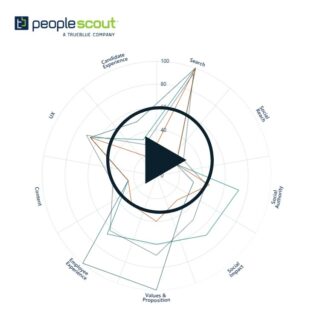Competition for talent is increasing across the globe, and employers are looking for innovative strategies to stay ahead of the competition. To gain a competitive advantage, employers are deploying a variety of methods. Wages are on the rise after years of slow growth. New graduates face strong prospects for employment. Even retirement is starting to look different for older workers with important skills. Finding new ways to source and attract workers with the skills of the future is a growing need.
In the U.S., years of job growth have led to the lowest unemployment rate in decades. Around the world, favorable job conditions are making it more difficult for employers to hire the talent they need. Adding to the challenge, employers are facing a skills shortage as they look to hire candidates who have the training, education and experience to bring their workforce into the future. This pressure is even greater in industries that are currently adapting to disruptive technology, like the auto industry. While reskilling and future degree programs can help increase the size of the talent pipeline in the future, employers still need to find and hire talent today. Building a talent community is a promising solution.
What is a Talent Community?
A talent community is a sourcing strategy that is an ongoing, multifaceted approach to candidate engagement that creates employment brand ambassadors and a talent pool that begins to feed itself. It is a process rather than an event and takes continual effort to maintain.
Traditional sourcing starts with a job opening. From there, a job description is written and disseminated. A sourcing specialist may search their contacts and social media to find a candidate with skills that match, but the process largely involves posting a job and waiting for the right candidate to find you.
In a talent community, the process is cyclical. It starts before a job requisition is created, and it doesn’t stop when a candidate is hired. Employers consistently build profiles of the types of candidates they would like for roles they may need to fill in the future. Then, employers need to build pipelines through technology, partnerships and employer branding initiatives to connect with those people, whether the employer currently has a job opening for that candidate or not. Finally, when a candidate gets to the point of applying, the experience throughout that process needs to be so strong that even candidates who do not make it through the process will become ambassadors for that brand and continue to apply for open positions in the future.
Building a talent community sourcing strategy has a host of benefits for employers. A community is sustainable. It can feed itself. This means decreased time-to-fill and cost-of-vacancy because candidates who are interested in working for an organization are waiting for a job to be posted rather than a recruiter posting a job and waiting for the right candidate to apply. It also leads to increased quality of hire because the employer has already determined the ideal candidate persona and has built a pipeline to find those people. When more qualified candidates are in that pipeline, the likelihood of making a strong hire goes up.
Why Talent Communities Alone Aren’t Enough
- They have to be combined with great employer branding.
- Your content has to be engaging and of value to the audience.
- You have to have the right mix of viable candidates with the skills and experience that your company values, and ambassadors for your employer brand.
- It is what you put into it, not what you take out–you have to cultivate the community or it will stagnate.
Using Employer Branding to Build a Talent Community
As employers work to create a talent community they need to build an employer brand that stands out from other organizations they compete with for talent. Organizations with a strong employer brand can stand out in a crowded landscape and draw in more candidates. There are several strategies employers can use to build their brands.
Online Talent Communities
An online talent community is a way to continue to communicate with candidates who may be interested in working for you in the future but can’t find a job opening that meets their skills and needs right now. It is also a way to engage with candidates who apply to jobs they aren’t qualified for yet but still have potential. An online community allows candidates to provide their contact information, resume and job interests. Then, the organization can search those resumes when a position opens, and it can send matching job openings to the candidate. This keeps the employer at the front of a candidate’s mind and provides recruiters with a slate of candidates every time a requisition opens.
Recruitment Email Marketing
Many organizations use email marketing as a part of their traditional marketing strategy, but it is also important in employment branding. Email marketing can be used in partnership with an online talent community. Organizations can send recruitment marketing emails to share job openings, as well as information about their culture. One caveat to using email marketing as a part of an employer branding strategy is that the emails should be as personalized as possible. A candidate who has provided their resume should only receive job openings that correspond with their skillsets. Data about candidates can also be used to personalize how often candidate receive emails or at what time of the day they are sent. Regulations like CAN-SPAM in the U.S. and GDPR in the EU regulate email marketing, and we discuss those later in this post.
Social Media
Every organization should have a strategy for sharing its employment brand on social media, though that strategy may look different for different companies. One option is to create a separate “careers” social media page where the organization can post job openings and information about the workplace, culture and current employees. At PeopleScout, we recommend this strategy to our clients and work with them to optimize their existing pages to showcase their employer brand. This strategy works well for employers with a strong brand presence and large volume of hires. Another option, especially for smaller organizations, is to include some employer branding on their traditional social media accounts. In this approach, employer branding related posts that share information about the workplace and culture should be interspersed between standard social media posts.
Video
Many employers are familiar with video interviewing, but video can enhance employer branding in several additional ways and doesn’t always need high production quality. One example is video job descriptions. A job posting could include a short video of a hiring manager talking about the job and what they are looking for. A video like this gives a candidate a better understanding of the job and gives them a glimpse into the culture of the organization. Additionally, organizations can use video to show workplace tours, so job seekers get an idea of what working for an organization might look like. If an organization is hiring for a lot of entry-level roles but frequently promotes within the company, a video that shows an employee’s career path from entry-level to a leadership role can also motivate candidates to apply for hard-to-fill entry-level jobs.
Chatting and Text
Another method of building a strong employer brand is communicating with candidates in the ways candidates want to communicate. Chat and text are growing in popularity. Some employers are deploying chatbots throughout their recruitment process. For others, a chat window with limited hours but access to a live recruiter can be successful. While many employers may be cautious to start a system to text messages candidates, several PeopleScout clients have found success and higher rates of candidate engagement.
Using Innovative Technology to Power a Talent Community
While a compelling employer brand is important for attracting strong candidates, it’s not enough to stay ahead in the current competitive landscape. Innovative technology solutions can help employers source top talent faster than the competition.
Geofencing
Geofencing can be used in a few different ways during the sourcing process. Much like targeted ads for restaurants or stores can be delivered to a person’s cell phone or computer based on where that person is located, job ads can be targeted to candidates in a specific geographical area as well. This can be valuable to employers that have a variety of locations spread across a large geographical area. Geofencing can be used to target job ads at candidates near specific branches. It can also be used for industry events or expos where a large number of potential candidates could be in one location at the same time.
AI Sourcing
Artificial intelligence sourcing can provide recruiters with a solid slate of candidates as soon as a requisition is opened, giving the recruiter a strong head start to fill the role. An AI sourcing solution that uses predictive analytics modeling can also provide the recruiter with information about how well the candidate matches the job opening and how likely the candidate is to leave their current role. With this information, recruiters are able to work more quickly and efficiently, filling the role with the best talent in less time. In the end, it saves companies time and money. At PeopleScout, AI sourcing is built into AffinixTM, PeopleScout’s proprietary talent technology solution.
AI Data Tracking
AI data tracking can be used to make other sourcing and employer branding strategies more effective. Artificial intelligence and predictive analytics can understand and predict candidate behaviors. By tracking what time of day candidates apply, open emails or use social media, employers can schedule email marketing and social media posts to maximize the number of candidates who will see and click on job postings. Employers can also use this data to optimize their ad spend on job boards, so the ads appear when the best candidates are most likely to be online. One PeopleScout client had data that showed most of its applicants applied after lunch on Wednesdays. By posting jobs just before that timeframe, the employer saw a 15 percent increase in applications.
Finding a Partner
As employers work to build their own talent communities, an RPO provider can be a valuable partner. The right RPO partner will have a wealth of knowledge gleaned from experience solving a wide variety of problems and successfully sourcing and recruiting in a number of markets and industries. Employers can benefit from that collective knowledge.
Additionally, working with an RPO partner provides compliance benefits. Many of the sourcing strategies addressed in this article are impacted by GDPR, CAN-SPAM and other regulations, as well as regulations by the OFCCP. RPO providers have years of experience with these regulations and strong checks in place to ensure all sourcing strategies are compliant. This can provide peace of mind for employers.
Employers working with RPO partners will also see financial benefits, including reducing or eliminating agency spend. At PeopleScout, some clients have gone from agency usage as high as 25 percent or more to zero. To accomplish that, employers need to be committed from the top down to building the sourcing infrastructure to implement a talent community.
To find an RPO partner who is a good fit, employers should look for providers who possess customizable offerings that can be adapted to meet every need. A one-size-fits-all approach ignores the specific needs of employers in different industries and the unique challenges that can arise in recruiting in different markets. To build a strong talent community, employers should look for an RPO partner who can successfully deploy and manage these innovative sourcing strategies.



